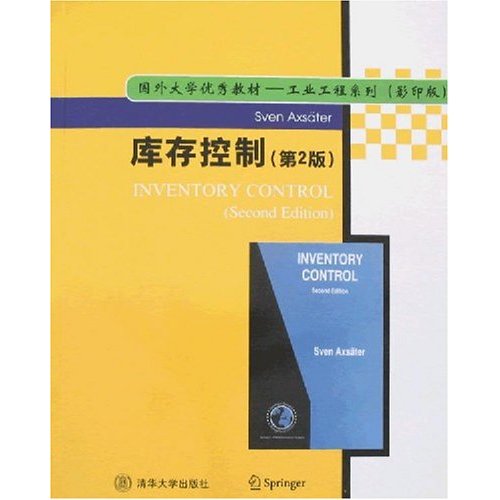《庫存控制(第2版)》是2012年出版的圖書,作者是[瑞]Sven Axsater。
基本介紹
- 書名:庫存控制(第2版)
- 作者:[瑞]Sven Axsater
- ISBN:9787302148180
- 定價:38元
- 出版時間:2012-8-8
- 裝幀:平裝
圖書目錄
1 INTRODUCTION
1.1 Importance and objectives of inventory control
1.2 Overview and purpose of the book
1.3 Framework
References
2 FORECASTING
2.1 Objectives and approaches
2.2 Demand models
2.2.1 Constant model
2.2.2 Trend model
2.2.3Trend-seasonal model
2.2.4 Choosing demand model
2.3 Moving average
2.4 Exponential smoothing
2.4.1 Updating procedure
2.4.2 Comparing exponential smoothly to moving average
2.4.3 Practical considerations and an example
2.5 Exponential smoothing with trend
2.5.1 Updating procedure
2.5.2 Practical considerations and an example
2.6 Winters’ trend-seasonal method
2.6.7 Updating procedure
2.6.2 Practical considerations and an example
2.7 Using regression analysis
2.7.1 Forecasting demand for a trend model
2.7.2 Practical considerations and an example
2.7.3 Forecasts based on other factors
2.7.4 More general regression models
2.8 Sporadic demand
2.9 Box-Jenkins techniques
2.10 Forecast errors
2.10.1 Common error measures
2.10.2 Updating MAD or o2
2.10.3 Determining the standard deviation as a function of demand
2.10.4 Forecast errors for other time periods
2.10.5 Sales data instead of demand data
2.11 Monitoring forecasts
2.11.1 Checking demand
2.11.2 Checking that the forecast represents the mean
2.12 Manual forecasts
References
Problems
3 COSTS AND CONCEPTS
3.1 Considered costs and other assumptions
3.1.1 Holding costs
3.1.2 Ordering or setup costs
3.1.3 Shortage costs or service constraints
3.1.4 0ther costs and assumptions
3.2 Different ordering systems
3.2.1 Inventory position
3.2.2 Continuous or periodic review
3.2.3 Different ordering policies
3.2.3.1 (R,Q)policy
3.2.3.2 (s,S)policy
References
4 SINGLE ECHELON SYSTEMS DETERMINISTlC LOT SIZING
4.1 The classical economic order quantity model
4.1.1 Optimal order quantity
4.1.2 Sensitivity analysis
4.1.3 Reorder point
4.2 Finite production rate
4.3 Quantity discounts
4.4 Backorders allowed
4.5 Time--varying demand
4.6 The Wagner-Whitin algorithm
……
5 SINGLE-ECHELON SYSTEMS:REORDER POINTS
6 SINGLE-ECHELON SYSTEMS:INTEGRATION-OPTIMALITY
7 COORDINATED ORDERING
8 MULTI-ECHELON SYSTEMS:STRCTURES AND ORDERING POLICIES
9 MULTI-ECHELON SYSTEMS:LOT SIZING
10 MULTI-ECHELON SYSTEMS:REORDER POINTS
11 IMPLEMENTATION
APPENDIX
ANSWRS AND HINTS TO PROBLEMS
APPENDIX
NORMAL DISTRIBUTION TABLES
INDEX
圖書簡介
讀者對象為工業工程、物流管理、企業管理等專業的高年級本科生和研究生,以及相關領域的科研人員和企業實際工作者。

